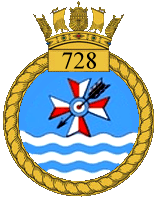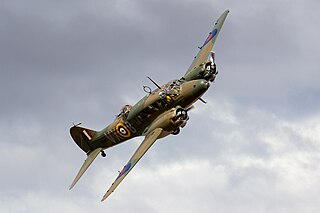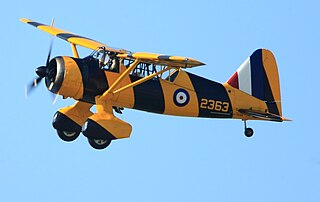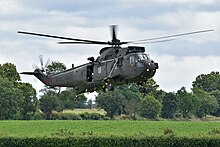
848 Naval Air Squadron was a squadron of the Royal Navy Fleet Air Arm. It operated the Westland Sea King HC.4 helicopter and previously provided advanced flying training to pilots for the other squadrons in the Commando Helicopter Force. The squadron was based at RNAS Yeovilton in Somerset and was decommissioned on 24 March 2016.

702 Naval Air Squadron was a Naval Air Squadron of the Royal Navy's Fleet Air Arm which last disbanded in August 2014. It was last based at HMS Heron, RNAS Yeovilton, Somerset and earlier at HMS Osprey, RNAS Portland, Dorset. As a training squadron it trained all ground and air crew for the sister front-line maritime Lynx unit, 815 Naval Air Squadron. It initially formed during July 1936 as a Catapult Flight for the 2nd Battle Squadron based at RAF Mount Batten and routinely embarking in RN ships such as, HMS Nelson, HMS Rodney and HMS Resolution. By 1939 it was known as 702 Naval Air Squadron but disbanded in January 1940.

701 Naval Air Squadron was a Royal Navy Fleet Air Arm squadron, which last disbanded during September 1958 at RNAS Lee-on-Solent where it was a Helicopter Trials, Communications and Fleet Requirements Unit. It initially formed during July 1936 as a Catapult Flight operating out of Malta and routinely embarking in RN ships such as, HMS Barham, HMS Malaya, HMS Valiant and HMS Warspite. By autumn 1939 it was known as 701 Naval Air Squadron but disbanded in January 1940. It was active twice more during the Second World War, between May 1940 and June 1941 on special duties and then between October 1942 and August 1943 performing anti-submarine patrols. Reforming in April 1945 it was designated a Communications Unit, operating out of Heston until disbanding in 1947. It last reformed as a Fleet Requirements Unit at HMS Daedalus, Lee-on-Solent, during October 1957.

703 Naval Air Squadron of the Fleet Air Arm of the Royal Navy was formed as a long-range catapult squadron on 3 March 1942 at RNAS Lee-on-Solent. During the Cold War, it was reformed as an experimental trials unit, and then as a helicopter training squadron. Since 2003, the squadron has formed the Royal Naval wing of the Defence Elementary Flying Training School at RAF Barkston Heath.

826 Naval Air Squadron was a Fleet Air Arm aircraft squadron formed during World War II which has been reformed several times since then until last disbanded in 1993.

737 Naval Air Squadron was a Naval Air Squadron of the Royal Navy's Fleet Air Arm. It was initially active during 1943 as an amphibious Bomber Reconnaissance Training Squadron. Reactivated in 1944 it operated as an ASV Training Unit until 1945. It was active again between 1949 and 1957. From 1959 it was the Anti-Submarine Warfare school at RNAS Portland. It operated Westland Wessex HAS.3 rescue helicopters from their land base at RNAS Portland, Dorset.

706 Naval Air Squadron was a Naval Air Squadron of the Royal Navy's Fleet Air Arm. Established as a fighter and torpedo-bomber training unit in Australia at the end of World War Two, it was briefly reformed as a helicopter squadron in the early 1950s, before becoming a helicopter training unit in 1962, and operating until 1998.

719 Naval Air Squadron was a Naval Air Squadron of the Royal Navy's Fleet Air Arm. It initially formed in 1944 as a Fighter Air Firing Training Squadron, at HMS Vulture, RNAS St Merryn, within the School of Air Combat, but at the start of 1945 it disbanded into 794 Naval Air Squadron. The squadron reformed in 1946 at HMS Owl, RNAS Fearn, as a Strike Training Squadron, before moving to HMS Gannet, RNAS Eglinton, where it became an Anti-submarine Training Squadron, disbanding there in 1949. The squadron reformed the following year at HMS Gannet as the Naval Air Anti-submarine School and remained there becoming the Naval Anti-Submarine Operational Flying School, eventually disbanding in 1959. However, in 1960, the squadron reformed, again at HMS Gannet, as the Joint Anti-submarine School Flight, this time operating helicopters. 719 Naval Air Squadron was granted first line status on 5 October 1961 and renumbered to 819 Naval Air Squadron.

728 Naval Air Squadron was a Naval Air Squadron of the Royal Navy's Fleet Air Arm (FAA). It was formed at the beginning of May in 1943, as a Fleet Requirements Unit, at RN Air Section Gibraltar. It provided detachments at RN Air Section Tafaraoui, in Algeria and later at RAF Oujda in Morocco. Moving to HMS Grebe, RNAS Dekheila, in Egypt, during June, it then merged into 775 Naval Air Squadron during July. It reformed in August, again as a Fleet Requirements Unit, at HMS Grebe, moving immediately to RN Air Section Takali, Malta. It provided target towing both for the Royal Navy's Mediterranean Fleet and the British Army, before later providing a detachment to tow targets for the United States Navy at Naples, Italy. The squadron remained on Malta, alternating between the airbases at Ta Kali, Luqa and Hal Far, until disbanding at the latter, in May 1967.
735 Naval Air Squadron was a Naval Air Squadron of the Royal Navy's Fleet Air Arm. It was active from 1943 as an ASV Radar Training Unit. Forming at HMS Nightjar, at RNAS Inskip, Lancashire, in 1944 the squadron moved to HMS Ringtail, RNAS Burscough, also in Lancashire. Various flights from the squadron moved on to form other Naval Air Squadrons, with the squadron eventually disbanding in 1946.

745 Naval Air Squadron was a Naval Air Squadron of the Royal Navy's Fleet Air Arm. It was initially active from 1943 to 1945 as a Telegraphist Air Gunner Training squadron, part of No.2 Telegraphist Air Gunner School based at R.N. Air Section Yarmouth, Nova Scotia, Canada. It reformed in April 1956 at HMS Gannet, RNAS Eglinton, Northern Ireland, as a Radar Jamming Trials Unit. It operated with four modified Grumman Avenger aircraft, undertaking a trials evaluation of the 'Orange Harvest' radar warning receiver equipment, disbanding in November 1957.

747 Naval Air Squadron was a Naval Air Squadron of the Royal Navy's Fleet Air Arm which last disbanded in December 1945. 747 Naval Air Squadron was part of the Torpedo Bomber Reconnaissance Pool and formed at HMS Owl, RNAS Fearn, in March 1943, evolving into an Operational Training Unit. July saw the squadron move to HMS Nightjar, RNAS Inskip and became part of No. 1 Naval Operational Training Unit. It returned to HMS Owl in January 1944 and then to HMS Urley, RNAS Ronaldsway, in July. In November 1945 the squadron headquarters moved to HMS Jackdaw, RNAS Crail, leaving a Flight at HMS Urley.

754 Naval Air Squadron was a Naval Air Squadron of the Royal Navy's Fleet Air Arm. It was active as an Observer Training Squadron from 1939 to 1944 as part of No. 2 Observer School, forming out of the School of Naval Co-operation RAF, in May 1939. It initially operated out of HMS Daedalus, RNAS Lee-on-Solent, Hampshire, however, after the Naval Air Station was attacked and bombed, it then moved to north to HMS Condor, RNAS Arbroath, Angus, Scotland, in September 1940. Here, it provided training for Observers and also Air Gunners and where four years later, in March 1944, it disbanded. The squadron then briefly reformed as a Air Gunner Training Squadron, as part of No. 1 Naval Air Gunners School, when 744 Naval Air Squadron was re-designated 754 Naval Air Squadron, in June 1944, at RN Air Section Yarmouth, Nova Scotia, Canada, until disbanding again, in March 1945.

772 Naval Air Squadron was a Naval Air Squadron of the Royal Navy's Fleet Air Arm which last disbanded during September 1995. 772 Naval Air Squadron formed as a Fleet Requirements Unit out of 'Y' Flight from 771 Naval Air Squadron at RNAS Lee-on-Solent in September 1939. While the headquarters remained there, floatplanes were operated out of RNAS Portland, however, mid 1940 saw the whole squadron move north to RNAS Campbeltown and roughly twelve months afterwards the short distance to RNAS Machrihanish. The unit moved to RNAS Ayr in July 1944 and became the Fleet Requirements Unit School. In January 1946 the squadron moved to RNAS Burscough in Lancashire, before moving to RNAS Anthorn in Cumberland, in May. It became the Northern Fleet Requirements Unit upon moving to RNAS Arbroath, in June 1947, but disbanded into 771 Naval Air Squadron in October. 772 Naval Air Squadron reformed as a Helicopter Support Squadron at RNAS Portland in September 1974. In September 1977 the squadron took over responsibility for a number of Ships' Flights of Royal Fleet Auxiliary ships. The squadron was used to reform 848 Naval Air Squadron for the Falklands Task Force in 1982, with the Ships' Flights absorbed into 847 Naval Air Squadron. In August 1982 it took on the Anti-Submarine Warfare Flight from 737 Naval Air Squadron and between 1983 - 1985 a Search and Rescue Flight operated out of RNAS Lee-on-Solent.

776 Naval Air Squadron was a Naval Air Squadron of the Royal Navy's Fleet Air Arm which last disbanded at the end of October 1945. 776 Naval Air Squadron formed as a Fleet Requirements Unit at HMS Daedalus, RNAS Lee-on-Solent, at the start of 1941. It operated a detachment at RN Air Section Speke in 1941 and one at RAF Woodvale in 1942, with the squadron wholly moving to Speke in the October. 1943 saw further detachments and these were deployed at RAF Llanbedr, RAF Millom, RAF Usworth and RAF Waltham. In April 1945, the Woodvale detachment was reabsorbed into the squadron when it relocated there, the airbase now operated by the Admiralty and known as HMS Ringtail II. It moved to HMS Ringtail, RNAS, Burscough, at the start of October 1945.

781 Naval Air Squadron was a Naval Air Squadron of the Royal Navy's Fleet Air Arm which disbanded at the end of March 1981. Planned as a Reserve Amphibious Bomber Reconnaissance squadron, it formed as a Communications Unit in March 1940 and operated a large variety of aircraft. It provided a Bristol Beaufighter conversion course which eventually became 798 Naval Air Squadron and also had a ‘B’ Flight at Heathrow and then Heston aerodromes before becoming 701 Naval Air Squadron. After the Allied invasion of Normandy the squadron flew to various Royal Navy units on the continent and established an ‘X’ Flight based in France and then Germany. In July 1945 the squadron disbanded into 782 Naval Air Squadron although the ‘X’ Flight was moved to 799 Naval Air Squadron.

783 Naval Air Squadron was a Naval Air Squadron of the Royal Navy's Fleet Air Arm which last disbanded in November 1949. 783 Naval Air Squadron was formed as an ASV Training Squadron at HMS Condor, RNAS Arbroath, Scotland, in January 1941. It operated a number of ‘flying classroom’ aircraft alongside other types. It operated in conjunction with the Naval Air Signals School (NASS) from March 1943. The squadron moved to HMS Daedalus, RNAS Lee-on-Solent, England, when the NASS moved south, also supporting the Flag Officer, Air, Home Communications Officer and from July 1948,it was part of the 51st Miscellaneous Air Group.

785 Naval Air Squadron was a Naval Air Squadron of the Royal Navy's Fleet Air Arm which disbanded in early 1946. 785 NAS formed as a Torpedo Bomber Reconnaissance Training Squadron, at HMS Jackdaw, RNAS Crail, in November 1940. Throughout its existence it operated a number of various types of torpedo bomber aircraft. The squadron became part of No. 1 Naval Operational Training Unit in late 1944.

786 Naval Air Squadron was a Naval Air Squadron of the Royal Navy's Fleet Air Arm which last disbanded in late 1945, absorbed by 785 Naval Air Squadron. 786 NAS formed at HMS Jackdaw, RNAS Crail, in November 1940, as a Torpedo Bomber Reconnaissance squadron. It operated a few different types of torpedo bomber aircraft, initially equipped with Fairey Albacore and shortly afterwards joined by Fairey Swordfish, these aircraft were replaced by Fairey Barracuda at the of 1942.

787 Naval Air Squadron was a Naval Air Squadron of the Royal Navy's Fleet Air Arm which disbanded in January 1956. It formed in March 1941, at HMS Heron, RNAS Yeovilton, out of 804 Naval Air Squadron as a Fleet Fighter Development Unit. Almost every type of fighter was received by the squadron for testing and evaluation for naval use. A move to RAF Duxford in June 1941 saw it become the Naval Air Fighting Development Unit, attached to the Royal Air Force's Air Fighting Development Unit. The squadron undertook rocket projectile test, continuous development of fighter tactics and even helping Torpedo Bomber Reconnaissance squadrons in evading fighter attack. Post Second World War it continued its trials task and also undertook Rebecca radar trials and ASH, US-built air-to-surface-vessel radar trials.




















